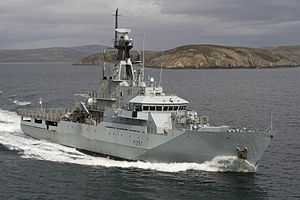HMS Clyde (P257)
 Exercising off the Falklands, 2014 | |
| Career (UK) | |
|---|---|
| Name: | HMS Clyde |
| Operator: | Royal Navy |
| Ordered: | 2005 |
| Builder: | VT Shipbuilding |
| Laid down: | 2005 |
| Launched: | 14 June 2006 |
| Sponsored by: | Mrs Lesley Dunt, wife of Vice Admiral Sir Peter Dunt (Retired) |
| Commissioned: | 30 January 2007 |
| Homeport: | HMNB Portsmouth |
| Identification: | P257 |
| Motto: |
Clwo "Strength" |
| Status: | in active service, as of 2015 |
| Badge: |
 |
| General characteristics | |
| Class and type: | River-class patrol vessel |
| Displacement: | 2,000 tonnes[1] |
| Length: | 81.5 meters |
| Beam: | 13.6 meters |
| Draught: | 4.1 meters |
| Propulsion: |
|
| Speed: | 21 kn (39 km/h) |
| Range: | 7,800 nautical miles (14,400 km) at 12 knots (22 km/h) |
| Boats and landing craft carried: |
|
| Complement: | 38 (accommodation for another 20) |
| Sensors and processing systems: | SCANTER 4100 2D air & surface surveillance radar |
| Armament: |
|
| Aircraft carried: | Sufficient size to take 1 × Lynx, Sea King or Merlin helicopter |
| Aviation facilities: |
|
HMS Clyde (pennant number P257) is an offshore patrol vessel and is the tenth ship in the Royal Navy to bear the name. She was launched on 14 June 2006 in Portsmouth Naval Base by VT Group shipbuilders in Portsmouth, England, and is the fourth vessel of the River class, with a displacement of 2,000 tonnes and a 30 mm Oerlikon KCB gun in place of the 20 mm gun fitted to Tyne River-class ships.
Operational history
Clyde was the first ship built entirely in Portsmouth Naval base for 40 years and has been constructed alongside the bow and superstructure sections for the new Type 45 destroyers Daring and Dauntless. She was named in a ceremony on 7 September 2006 as she had not received a traditional launching ceremony.[2]
HMS Clyde was commissioned into the Royal Navy in a ceremony at Portsmouth Naval base on 30 January 2007.[3] She and her ship's company went through a rigorous series of trials and safety training before undergoing operational sea training off Scotland.
After being commissioned into active service she was sent to the South Atlantic to relieve HMS Dumbarton Castle as the Royal Navy's patrol vessel in the area based in the Falkland Islands. Unlike predecessors in this role Clyde will stay in South Atlantic waters for the foreseeable future, with a contract in place for her to remain in the Falkland Islands until 2018.
In January 2011, the government of Brazil denied HMS Clyde access to Rio de Janeiro in solidarity with Argentinian claims over the Falkland Islands sovereignty dispute,[4][5] as Uruguay had done with HMS Gloucester the previous September.

See also
References
- ↑ Royal Navy HMS Clyde, royalnavy.mod.uk, Retrieved 8 June 2014. Quote - "As part of her deterrence role she also regularly visits other British Overseas Territories in the area such as South Georgia and the South Sandwich Islands. At just over 2,000 tonnes displacement, she may not be the biggest ship in the Navy, but this is certainly made up for in capability."
- ↑ Royal Navy press release on launching of Clyde retrieved 11 September 2006
- ↑ Royal Navy press release on acceptance into fleet retrieved 29 January 2007
- ↑ Brasil le prohibió amarrar en Río a un buque británico de Malvinas Brasil le prohibió amarrar en Río a un buque británico de Malvinas
- ↑ Brasil le prohibió el ingreso a un buque de guerra británico
External links
- Royal Navy HMS Clyde (royalnavy.mod.uk)
 Media related to HMS Clyde (P257) at Wikimedia Commons
Media related to HMS Clyde (P257) at Wikimedia Commons
| ||||||||||||||||||||||||||||||||||||||||||||||||||||||||||||||||||||||||||||||||||||||||||